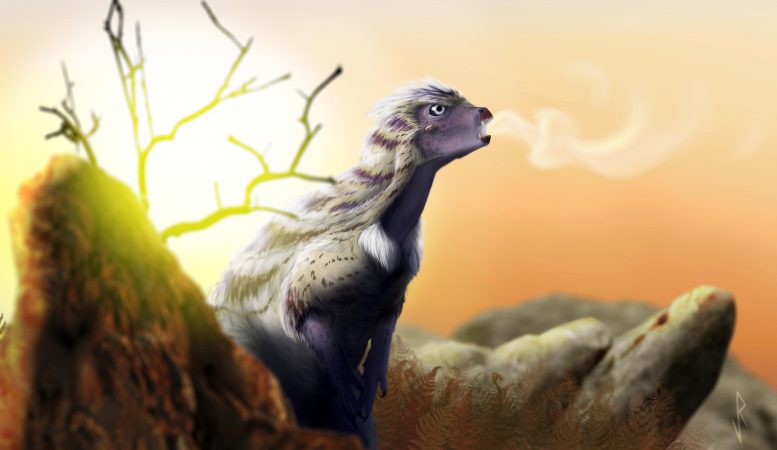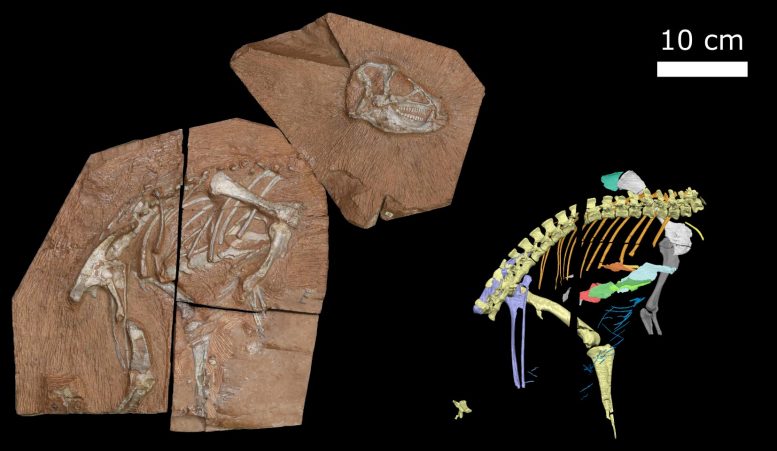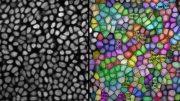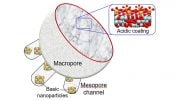
Life reconstruction of Heterodontosaurus vocalizing on a cool Jurassic morning. Credit: Viktor Radermacher
An international team of scientists has used high-powered X-rays at the European Synchrotron, the ESRF, to show how an extinct South African 200-million-year-old dinosaur, Heterodontosaurus tucki, breathed. The study was published in eLife on July 6, 2021.
In 2016, scientists from the Evolutionary Studies Institute at the University of the Witwatersrand in Johannesburg, South Africa, came to the ESRF, the European Synchrotron in Grenoble, France, the brightest synchrotron light source, for an exceptional study: to scan the complete skeleton of a small, 200-million-year-old plant-eating dinosaur. The dinosaur specimen is the most complete fossil ever discovered of a species known as Heterodontosaurus tucki. The fossil was found in 2009 in the Eastern Cape of South Africa by study co-author, Billy de Klerk of the Albany Museum, Makhanda, South Africa. “A farmer friend of mine called my attention to the specimen,” says de Klerk, “and when I saw it I immediately knew we had something special on our hands.”
Fast forward some years: the team of scientists, using scans and new algorithm developed by ESRF scientists to virtually reconstruct the skeleton of Heterodontosaurus in unprecedented detail, and thus show how this extinct dinosaur breathed. “This specimen represents a turning point in understanding how dinosaurs evolved” explains Viktor Radermacher, corresponding author, South African PhD now at the University of Minnesota, US.
Digital Heterodontosaurus South African dinosaur skeleton produced by the scanning at the ESRFn the European Synchrotron, France, that shows complete specimen and new anatomy. Credit: Vincent Fernandez, ESRF, NMHN
Not all animals use the same techniques and organs to breathe. Humans expand and contract their lungs. Birds have air sacs outside their lungs that pump oxygen in, and their lungs don’t actually move. For a long time, paleontologists assumed that all dinosaurs breathed like birds, since they had similar breathing anatomy. This study, however, found that Heterodontosaurus did not–it instead had paddle-shaped ribs and small, toothpick-like bones, and expanded both its chest and belly in order to breathe.
Heterodontosaurus is one of the oldest and first-evolving Ornithischians, the group that includes favorites like Triceratops, Stegosaurus, and duckbilled dinosaurs. Heterodontosaurus lived in the early Jurassic period, about 200 million years ago, surviving an extinction at the end of the prior Triassic period. Understanding how this dinosaur breathed could also help paleontologists figure out what biological features allowed certain dinosaurs to survive or caused them to go extinct.
“We’ve long known that the skeletons of ornithischian dinosaurs were radically different from those of other dinosaurs,” explains Richard Butler, from the School of Geography, Earth, and Environmental Sciences, University of Birmingham, UK. “This amazing new fossil helps us understand why ornithischians were so distinctive and successful,” he adds.

The new Heterodontosaurus tucki specimen AM 4766 affectionately called “Tucky.” Digitally reconstructed anatomy on the right, thanks to ESRF scans. Credit: Viktor Radermacher
This study is the result of a long-standing collaboration between paleontologists based in South Africa and at the ESRF, where non-invasive techniques have been developed specifically for palaeontological studies. “You could only do this study with a synchrotron,” says Vincent Fernandez, scientist at the Natural History Museum in London, UK, co-author of the study and former ESRF scientist. “The characteristics of the ESRF’s X-rays, combined with its high energy beamline configuration, made scanning this complete turkey-sized dinosaur possible.”
This is a perfect example of the diversity of life on Earth. “The takeaway message is that there are many ways to breathe,” Radermacher said. “And the really interesting thing about life on earth is that we all have different strategies to do the same thing, and we’ve just identified a new strategy of breathing.”
“Studies like this highlight how South Africa’s fossil record once again helps us understand evolutionary origins,” said senior author Jonah Choiniere, Professor at the Evolutionary Studies Institute, University of the Witwatersrand, South Africa.
Reference: “A new Heterodontosaurus specimen elucidates the unique ventilatory macroevolution of ornithischian dinosaurs” by Viktor J Radermacher, Vincent Fernandez, Emma R Schachner, Richard J Butler, Emese M Bordy, Michael Naylor Hudgins, William J de Klerk, Kimberley EJ Chapelle and Jonah N Choiniere, 6 July 2021, eLife.
DOI: 10.7554/eLife.66036
Authors Viktor Radermacher, Kimberley Chapelle, and Jonah Choiniere were supported by grants from the NRF-African Origins Platform, Centre of Excellence in Palaeosciences, and the Palaeontological Scientific Trust. South African participation in the ESRF, the European synchrotron, is supported by the NRF and DSI.









Nice 1 keep it up